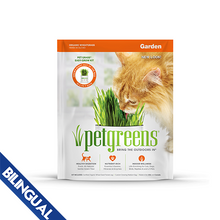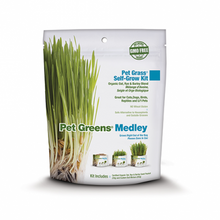Grow organic greens right out of the bag! Pet Greens® Self Grow Garden is GMO-free Pet Grass seeds and custom soil in a ready-to-grow bag. Just add water and in about a week you will have an all-natural, nutrient-rich treat for your pet! Cereal grasses benefit your pet's health by aiding in digestion for all animals, helping to control hairballs for cats and providing calcium for reptiles. Birds also love to juice and prune the blades.
BAG GROWING DIRECTIONS:
Before tearing open the bag, turn it over and carefully make about 10 small holes in the bottom with a ballpoint pen, large paper clip or other sharpish, poker-type thing. PLEASE be careful not to poke your fingers or other body parts!
Tear open the bag at the top, where there’s a conveniently-provided notch for this purpose. (Note: we’re not at the cutting-the-bag-with scissors part yet – that comes in step 4)
Remove the small foil packet of seeds with growing instructions printed on it.
Now you can cut the bag along the dotted line where the little scissors symbol appears (about halfway down the bag.)
Open the foil packet and spread the seeds evenly across the top of the soil. Then lightly mix the seeds into the top 1/4 inch of soil – just enough so that they are covered, but not too deep.
Place the bag on a saucer or in a shallow bowl. An aluminum pie pan works great, too. CAREFULLY pour about 1 cup of water into the bag, trying not to disturb the seeds as much as possible. Once the water soaks in, if there are a lot of seeds resting on top of the soil you can just poke them down a bit with your finger.
Place the bag and saucer/tray in a warm, out-of-the-way place that does not get a lot of light. Check the bag daily to make sure the soil stays moist, and water as needed.
Your seeds should start to sprout in about 3 days. Once you see the little sprouts poking up out of the soil, move the bag and saucer to a bright, well ventilated location (although not in direct sunlight). At this point you want to water about every 3 days, or more frequently if necessary to prevent the soil from drying out completely.
That’s it! Your Pet Greens® Garden is ready for your pets to enjoy when the grass reaches about 2 inches in height. It can grow up to 7” high, but should be trimmed at about the 5” point to keep it fresh and healthy. For more information and tips on keeping your Pet Grass® fresher longer, please go to the tips section on this site.
CARE INSTRUCTIONS & HELPFUL HINTS
Pet Grass is the nutrient-rich sprout of cereal grass (wheat, oat, rye and barley grasses) that will love and grow for about two to three weeks with proper care. Pet Grass cannot be re-potted or transplanted and should be replaced on a regular basis.
WATERING:
Pet Grass should typically be watered twice per week. The best way to water your Pet Grass is to set the container in a shallow bowl with about 1″ of water. Allow the Pet Grass to soak up the water it needs for about one hour, then pour off any remaining water and allow the container to drain.
LIGHT & VENTILATION:
Place your Pet Grass in a bright, well-ventilated location. A window sill that gets indirect sunlight is perfect. Keep in mind, however, that the more light and warmth your Pet Grass receives, the faster it will grow, so you don’t want to overdo it if you want your Pet Grass to last awhile. The best way to extend the life of your Pet Grass is to refrigerate the container overnight or when not in use.
FEEDING:
Feed to your pet as a healthy reward or snack. Pet grass can be fed to cats, dogs, birds, reptiles, and small animals like rabbits, hamsters and guinea pigs. Keep in mind that it is intended as a healthy treat or snack – and please consult your veterinarian for more information about the proper serving size for your pet(s).






